Tropical agriculture "double-whammy": high emissions, low yields
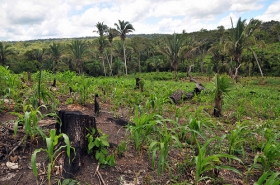
Food produced in the tropics comes with high carbon emissions and low crop yields, according to a new study in the Proceedings of the National Academy of Sciences (PNAS). In the most comprehensive and detailed study to date looking at carbon emissions versus crop yields, researchers found that food produced in the tropics releases almost double the amount of carbon while producing half the yield as food produced in temperate regions. In other words, temperate food production is three times more efficient in terms of yield and carbon emissions.
"Tropical forests store a tremendous amount of carbon, and when a forest is cleared, not only do you lose more carbon, but crop yields are not nearly as high as they are in temperate areas," explains lead author Paul C. West, a graduate student at the University of Wisconsin-Madison, in a press release.
The researchers found that one ton of food emitted approximately over 75 tons of carbon in the tropics, whereas a ton of food grown in temperate regions released just less than 27 tons of carbon.
"This creates a kind of 'double whammy' for a lot of tropical agriculture: we have to clear carbon-rich ecosystems to create tropical croplands, and unfortunately they often have lower yields than temperate systems," says co-author Jonathan Foley, director of the University of Minnesota's Institute on the Environment. "In terms of balancing the needs of food production and slowing carbon dioxide emissions, this is a tough tradeoff."
Food produced in the tropics comes with
high carbon emissions and low crop yields, according to a new study in
the Proceedings of the National Academy of Sciences (PNAS). In
the most comprehensive and detailed study to date looking at carbon
emissions versus crop yields, researchers found that food produced in
the tropics releases almost double the amount of carbon while producing
half the yield as food produced in temperate regions. In other words,
temperate food production is three times more efficient in terms of
yield and carbon emissions.
"Tropical forests store a tremendous amount of carbon, and when a forest
is cleared, not only do you lose more carbon, but crop yields are not
nearly as high as they are in temperate areas," explains lead author
Paul C. West, a graduate student at the University of Wisconsin-Madison,
in a press release.
The researchers
found that one ton of food emitted approximately over 75 tons of carbon
in the tropics, whereas a ton of food grown in temperate regions
released just less than 27 tons of carbon.
"This creates a kind of 'double whammy' for a lot of tropical
agriculture: we have to clear carbon-rich ecosystems to create tropical
croplands, and unfortunately they often have lower yields than temperate
systems," says co-author Jonathan Foley, director of the University of
Minnesota's Institute on the Environment. "In terms of balancing the
needs of food production and slowing carbon dioxide emissions, this is a
tough tradeoff."
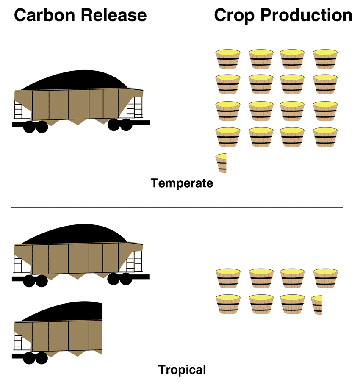
The tradeoffs between the release of carbon to the atmosphere
and agricultural production are markedly different between the
world's temperate and tropical regions. In this representation,
for each hectare of land cleared for agriculture, each rail car
is equivalent to 68 tons of carbon released to the atmosphere
and each bushel represents 3.9 tons of maize produced. Image
courtesy of Paul West, University of Wisconsin-Madison Center
for Sustainability and the Global Environment and University of
Wisconsin-Madison Center for Limnology.
Rising human population, increasing consumption of meat (which requires
more grain per area), the demand for biofuels, high commodity prices,
and economic development plans have pushed many tropical nations to
pursue large-scale agriculture over forest protection. However, the
authors say the realities of carbon loss in the tropics makes a strong
argument for intensifying agriculture on already cleared land, rather
than more deforestation.
"Our results corroborate recommendations to concentrate reforestation
and avoid deforestation in the tropics to have the greatest worldwide
impact," the authors write.
But, West admits, "the realty is there will be some of both [agriculture
intensification and deforestation]."
The authors explain in the paper that "despite the clear benefits of
concentrating reforestation and forest conservation efforts in the
tropics, several local and regional factors influence implementation.
[…] Choices are made locally and are influenced by local and regional
food security, transportation costs, labor, poverty, and technology
rather than global atmospheric carbon. Thus, local and global outcomes
must be coupled to manage ecosystem services and assess their
tradeoffs."
The study also highlight that agriculture comes with additional
tradeoffs on top of carbon including impacting ecosystem services such
as "soil and groundwater recharge, runoff, and nutrient regulation as
well as ecosystems, species, and genome diversity of landscapes."
The broad study looked at 175 different crops worldwide using government
data and satellite imagery.
"We have a very fine resolution of both what the carbon stocks and the
yields are globally," says West. "Spatially, it is much more explicit
than anything that has been produced before."
Approximately 20% of the temperate region is used for crops, as opposed
to 10.5% of the tropics. In all, deforestation contributes more
greenhouse gases to the atmosphere than global transportation: 12-20% of
the total greenhouse gas emissions are due to the loss of forests.
Scientists say that such emissions are driving global climate change.
CITATION: Paul C. West, Holly K. Gibbs, Chad Monfreda, John Wagner,
Carol C. Barford, Stephen R. Carpenter, and Jonathan A. Foley.
Trading carbon for food: Global comparison of carbon stocks vs. crop
yields on agricultural land. PNAS. DOI: 10.1073/pnas.1011078107.
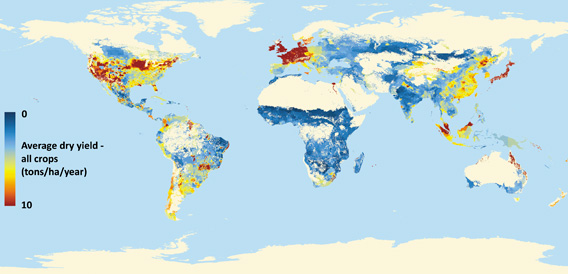
Crop types and yields between 1998 and 2002. Highest crop yields are
in temperate regions of Western Europe and North America. Map courtesy
of Paul West, University of Wisconsin-Madison Center for Sustainability
and the Global Environment and University of Wisconsin-Madison Center
for Limnology. Click to enlarge.
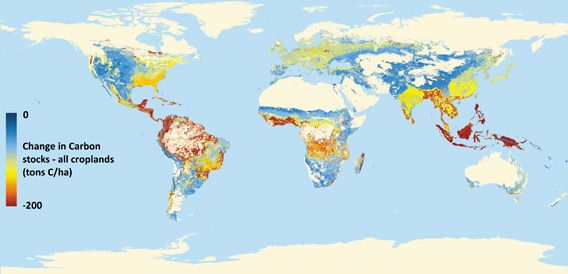
Map shows changes in carbon stocks due to cropland conversion. Blue
is less carbon emissions due to land conversion, while red is more.
Tropical areas with high conversion of croplands, such as Southeast
Asia, have the highest emissions due to land conversion. Map courtesy of
Paul West, University of Wisconsin-Madison Center for Sustainability and
the Global Environment and University of Wisconsin-Madison Center for
Limnology.Click to enlarge.
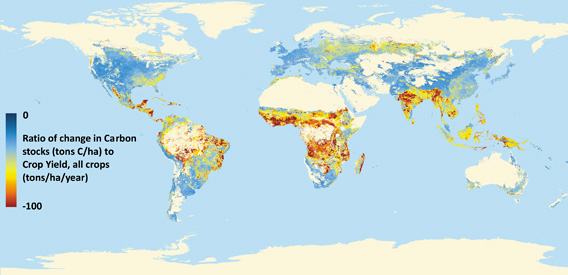
Combining cropland distribution and changes in carbon stocks due to
crop expansion into native ecosystems shows that carbon loss per ton of
annual crop yield is nearly three times as high in the tropics compared
to temperate regions. Map courtesy of Paul West, University of
Wisconsin-Madison Center for Sustainability and the Global Environment
and University of Wisconsin-Madison Center for Limnology.Click to
enlarge.
Article originally published: http://news.mongabay.com/2010/1102-hance_tropical_agriculture.html